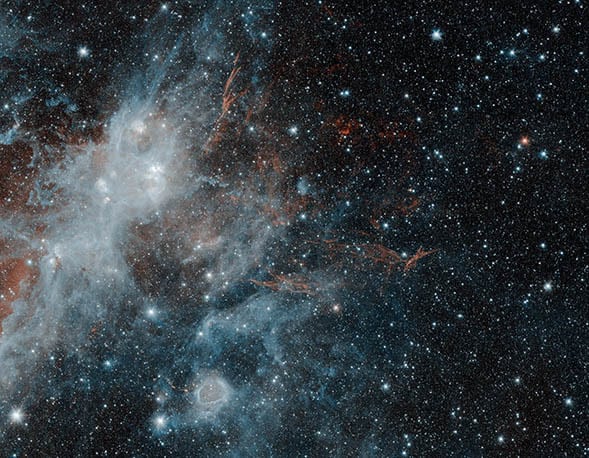Blog
Thin, red veins of energized gas mark the location of the supernova remnant HBH3 in this image from NASA’s Spitzer Space Telescope. The puffy, white feature in the image is a portion of the star forming regions W3, W4 and W5. Infrared wavelengths of 3.6 microns have been mapped to blue, and 4.5 microns to red. The white color of the star-forming region is a combination of both wavelengths, while the HBH3 filaments radiate only at the longer 4.5 micron wavelength.
NASA’s Jet Propulsion Laboratory, Pasadena, California, manages the Spitzer Space Telescope mission for NASA’s Science Mission Directorate, Washington. Science operations are conducted at the Spitzer Science Center at Caltech in Pasadena, California. Spacecraft operations are based at Lockheed Martin Space Systems Company, Littleton, Colorado. Data are archived at the Infrared Science Archive housed at the Infrared Processing and Analysis Center at Caltech. Caltech manages JPL for NASA.

Otis Lee Clay (February 11, 1942 – January 8, 2016) was an American R&B and soul singer, who started in gospel music. In 2013, Clay was inducted to the Blues Hall of Fame. Clay was born in Waxhaw, Mississippi to a musical family, who moved in 1953 to Muncie, Indiana. After singing with local gospel group, the Voices of Hope, he returned to Mississippi to sing with the Christian Travelers, before settling in Chicago in 1957. There, he joined a series of gospel vocal groups including the Golden Jubilaires, the Famous Blue Jay Singers, the Holy Wonders, and the Pilgrim Harmonizers, before making his first solo secular recordings in 1962. They were unissued, and Clay joined the Gospel Songbirds, who recorded in Nashville in 1964 and who also included Maurice Dollison who sang R&B under the name Cash McCall, and then the Sensational Nightingales.
In 1965 Clay signed with One-derful! Records in Chicago, to make secular recordings. After releasing a series of gospel-tinged soul records, his first hit came in 1967 with “That’s How It Is (When You’re In Love)”, which reached # 34 on the US Billboard R&B chart, followed by “A Lasting Love” (# 48 R&B). In 1968 the record company folded and his contract was bought by Atlantic Records, who launched their subsidiary Cotillion label with Clay’s version of the Sir Douglas Quintet hit, “She’s About A Mover”, produced at the FAME Studios in Muscle Shoals. The record became Clay’s biggest pop hit, reaching # 97 on the Billboard Hot 100 (# 47 R&B). However, follow-ups on Cotillion, including “Hard Working Woman” produced by Syl Johnson, and “Is It Over?” produced by Willie Mitchell in Memphis, were less successful.
more...Little Johnny Taylor (born Johnny Lamont Merrett; February 11, 1943 – May 17, 2002) was an American blues and soul singer, who made recordings throughout the 1960s and 1970s, and continued public performances through the 1980s and 1990s.
Born in Gregory, Arkansas, United States, he is frequently confused with his contemporary and near namesake Johnnie Taylor, especially since the latter made a cover version of the song that Little Johnny Taylor was most famous for, “Part Time Love” (1963), and the fact that both men began their careers as gospel singers.
Little Johnny Taylor moved to Los Angeles in 1950, and sang with the Mighty Clouds of Joy before moving into secular music. Influenced by Little Willie John, he first recorded as an R&B artist for the Swingin’ record label.
However, he did not achieve major success until signing for San Francisco-based Fantasy Records‘ subsidiary label, Galaxy. His first hit was the mid-tempo blues “You’ll Need Another Favor,” sung in the style of Bobby Bland, with arrangement by Ray Shanklin and produced by Cliff Goldsmith. The follow-up, “Part Time Love“, written by Clay Hammond and featuring Arthur Wright on guitar, became his biggest hit, reaching number 1 in the U.S. Billboard R&B chart, and number 19 on the pop chart, in October 1963. However, follow-ups on the Galaxy label were much less successful.
more...Sérgio Santos Mendes (Brazilian Portuguese: [ˈsɛʁʒju ˈsɐ̃tuz ˈmẽdʒis]; born February 11, 1941) is a Brazilian musician. He has over 55 releases, and plays bossa nova heavily crossed with jazz and funk. He was nominated for an Oscar for Best Original Song in 2012 as co-writer of the song “Real in Rio” from the animated film Rio.
Mendes is a unique example of a Brazilian musician primarily known in the United States, where his albums were recorded and where most of his touring took place.
Mendes is married to Gracinha Leporace, who has performed with him since the early 1970s. Mendes has also collaborated with many artists through the years, including The Black Eyed Peas, with whom he re-recorded in 2006 a version of his breakthrough hit “Mas Que Nada“.
https://www.youtube.com/watch?v=A0OM_Zmfl1o
more...
Joshua Daniel White (February 11, 1914 – September 5, 1969) was an American singer, guitarist, songwriter, actor and civil rights activist. He also recorded under the names Pinewood Tom and Tippy Barton in the 1930s.
White grew up in the South during the 1920s and 1930s. He became a prominent race records artist, with a prolific output of recordings in genres including Piedmont blues, country blues, gospel music, and social protest songs. In 1931, White moved to New York, and within a decade his fame had spread widely. His repertoire expanded to include urban blues, jazz, traditional folk songs, and political protest songs, and he was in demand as an actor on radio, Broadway, and film.
However, White’s anti-segregationist and international human rights political stance presented in many of his recordings and in his speeches at rallies were subsequently used by McCarthyites as a pretext for labeling him a communist to slander and harass him. From 1947 through the mid-1960s, White was caught up in the anti-communist Red Scare, and as a consequence his career was damaged. However White’s musical style would go on to influence several generations of musical artists.
White was born on February 11, 1914, in the black section of Greenville, South Carolina, one of the four children of Reverend Dennis and Daisy Elizabeth White. His father told him that he was named after the Biblical character Joshua of the Old Testament. His mother introduced him to music when he was five years old, at which age he began singing in his church’s choir. White’s father threw a white bill collector out of his home in 1921, for which he was beaten so badly that he nearly died, and then was locked up in a mental institution, where he died nine years later
more...KARIBUNI East African Music Ensemble performing at Capitol Hill Magnet School 560 Concordia Ave, St Paul, MN 55103 1015 & 1130am sets with Joe Shalita, Bingo Sei Kpolar and Mick LaBriola. Monday February 10th 2020.

This bright, somewhat blob-like object — seen in this stunning picture as observed by the NASA/ESA Hubble Space Telescope — is a galaxy named NGC 1803. It is about 200 million light-years away, in the southern constellation of Pictor (The Painter’s Easel).
NGC 1803 was discovered in 1834 by astronomer John Herschel. Herschel is a big name in astronomy; John, his father William, and his aunt Caroline all made huge contributions to the field, and their legacies remain today. William systematically cataloged many of the objects he viewed in the night sky, named many moons in the Solar System, discovered infrared radiation, and more. Caroline discovered several comets and nebulae. John took this aforementioned catalog of night-sky objects and reworked and expanded it into his General Catalogue of Nebulae and Clusters of Stars. This was the basis for the cataloging system still used today by astronomers (Dreyer’s New General Catalogue of Nebulae and Clusters of Stars, or the New General Catalogue for short).
This gives rise to the NGC names assigned to a vast number of galaxies — including NGC 1803. This galaxy is one of a galactic pair. It was described by Dreyer as being “faint, small, [and] round”, and located near to a very bright star to the southeast. This star is in fact the nebulous lenticular galaxy PGC 16720 — not visible in this image.

Roland Pembroke Hanna (February 10, 1932 – November 13, 2002) was an American jazz pianist, composer, and teacher.
Hanna studied classical piano from the age of 11, but was strongly interested in jazz, having been introduced to it by his friend, pianist Tommy Flanagan. This interest increased after his time in military service, 1950–52. He studied briefly at the Eastman School of Music in 1953 and then enrolled at the Juilliard School when he moved to New York two years later. He worked with several big names in the 1950s, including Benny Goodman and Charles Mingus, and graduated in 1960. Between 1963 and 1966 Hanna led his own trio, then from 1966 to 1974 he was a regular member of the Thad Jones/Mel Lewis Orchestra. Hanna also toured the Soviet Union with this orchestra in 1972. During the 1970s he was a member of the New York Jazz Quartet.
more...Rufus Reid (born February 10, 1944, in Atlanta, Georgia) is an American jazz bassist, educator, and composer.
Reid was raised in Sacramento, California, where he played the trumpet through junior high and high school. Upon graduation from Sacramento High School, he entered the United States Air Force as a trumpet player. During that period he began to be seriously interested in the bass.
After fulfilling his duties in the military, Rufus had decided he wanted to pursue a career as a professional bassist. He moved to Seattle, Washington, where he began serious study with James Harnett of the Seattle Symphony. He continued his education at Northwestern University in Evanston, Illinois, where he studied with Warren Benfield and principal bassist, Joseph Guastefeste, both of the Chicago Symphony. He graduated in 1971 with a Bachelor of Music Degree as a Performance Major on the Double Bass.
Rufus Reid’s major professional career began in Chicago and continues since 1976 in New York City. Playing with hundreds of the world’s greatest musicians, he is famously the bassist that saxophonist Dexter Gordon chose when he returned to the states from his decade-long exile in Denmark. His colleagues include Thad Jones, Nancy Wilson, Eddie Harris, and Bob Berg.
Reid has been a resident of Teaneck, New Jersey.
more...Emmanuel N’Djoké Dibango (born 12 December 1933) is a Cameroonian musician and songwriter who plays saxophone and vibraphone. He developed a musical style fusing jazz, funk, and traditional Cameroonian music. His father was a member of the Yabassi ethnic group, though his mother was a Duala. He is best known for his 1972 single “Soul Makossa“.
Dibango was born in Douala, Cameroon. His father, Michel Manfred N’Djoké Dibango, was a civil servant. Son of a farmer, he met his wife travelling by pirogue to her residence, Douala. A literate woman, she was a fashion designer, running her own small business. Both her ethnic group, the Duala, and his, the Yabassi, viewed this union of different ethnic groups with some disdain. Emmanuel had no siblings, although he had a stepbrother from his father’s previous marriage who was four years older than he was. In Cameroon, one’s ethnicity is dictated by one’s father, though Dibango wrote in his autobiography, Three Kilos of Coffee, that he has “never been able to identify completely with either of [his] parents.”
Dibango’s uncle was the leader of his extended family. Upon his death, Dibango’s father refused to take over, as he never fully initiated his son into the Yabassi’s customs. Throughout his childhood, Dibango slowly forgot the Yabassi language in favour of the Duala. However, his family did live in the Yabassi encampment on the Yabassi plateau, close to the Wouri River in central Douala. While a child, Dibango attended Protestant church every night for religious education, or nkouaida. He enjoyed studying music there, and reportedly was a fast learner.
more...William Henry “Chick” Webb (February 10, 1905–June 16, 1939) was an American jazz and swing music drummer as well as a band leader.
Webb was born in Baltimore, Maryland, to William H. and Marie Webb. When an infant, he fell down some stair steps in his family’s home, crushing several vertebrae and requiring surgery, from which he never regained full mobility. The injury progressed to tuberculosis of the spine, leaving him with short stature and a badly deformed spine which caused him to appear hunchbacked.The idea of playing an instrument was suggested by his doctor to “loosen up” his bones. He supported himself as a newspaper boy to save enough money to buy drums, and first played professionally at age 11. Webb had three sisters: Bessie, Mabel and Ethel. Mabel married Wilbur Porter around 1928.
At the age of 17 he moved to New York City and by 1926 was leading his own band in Harlem. Jazz drummer Tommy Benford said he gave Webb drum lessons when he first reached New York.
He alternated between band tours and residencies at New York City clubs through the late 1920s. In 1931, his band became the house band at the Savoy Ballroom. He became one of the best-regarded bandleaders and drummers of the new “swing” style. Drummer Buddy Rich cited Webb’s powerful technique and virtuoso performances as heavily influential on his own drumming, and even referred to Webb as “the daddy of them all”. Webb was unable to read music, and instead memorized the arrangements played by the band and conducted from a platform in the center. He used custom-made pedals, goose-neck cymbal holders, a 28-inch bass drum and other percussion instruments.
Although his band was not as influential, it was feared in the battle of the bands. The Savoy often featured “Battle of the Bands” where Webb’s band would compete with other top bands, such as the Benny Goodman Orchestra or the Count Basie Orchestra. By the end of the night’s battles the dancers seemed always to have voted Webb’s band as the best. Webb lost to Duke Ellington in 1937. Although a judge declared Webb’s band the official winner in 1938 over Count Basie’s, and Basie himself said he was relieved to come away from the contest without embarrassing himself, surviving musicians continued to dispute the ruling for decades.
more...https://www.youtube.com/watch?v=dvDpYBFcLyQ
more...https://www.youtube.com/watch?v=GW-ffdHybQY
more...NGC 7541, seen here as viewed by the NASA/ESA Hubble Space Telescope, in the constellation of Pisces (The Fishes).
A barred spiral is a galaxy with whirling, pinwheeling, spiral arms, and a bright center that is intersected by a bar of gas and stars. This bar cuts directly through the galaxy’s central region, and is thought to invigorate the region somewhat, sparking activity and fuelling myriad processes that may otherwise have never occurred or have previously ground to a halt (star formation and active galactic nuclei being key examples). We think bars exist in up to two-thirds of all spiral galaxies, including our own home, the Milky Way.
NGC 7541 is actually observed to have a higher-than-usual star formation rate, adding weight to the theory that spiral bars act as stellar nurseries, corralling and funneling inwards the material and fuel needed to create and nurture new baby stars. Along with its nearby companion NGC 7537, the galaxy makes up a pair of galaxies located about 110 million light-years away from us.

Carole King (born Carol Joan Klein, February 9, 1942) is an American singer-songwriter who has been active since 1958, initially as one of the staff songwriters at the Brill Building and later as a solo artist. She is the most successful female songwriter of the latter half of the 20th century in the US, having written or co-written 118 pop hits on the Billboard Hot 100. King also wrote 61 hits that charted in the UK, making her the most successful female songwriter on the UK singles charts between 1952 and 2005.
King’s major success began in the 1960s when she and her first husband, Gerry Goffin, wrote more than two dozen chart hits, many of which have become standards, for numerous artists. She has continued writing for other artists since then. King’s success as a performer in her own right did not come until the 1970s, when she sang her own songs, accompanying herself on the piano, in a series of albums and concerts. After experiencing commercial disappointment with her debut album Writer, King scored her breakthrough with the album Tapestry, which topped the U.S. album chart for 15 weeks in 1971 and remained on the charts for more than six years.
King has made 25 solo albums, the most successful being Tapestry, which held the record for most weeks at No. 1 by a female artist for more than 20 years. Her record sales were estimated at more than 75 million copies worldwide. She has won four Grammy Awards and was inducted into the Songwriters Hall of Fame and the Rock and Roll Hall of Fame for her songwriting. She is the recipient of the 2013 Library of Congress Gershwin Prizefor Popular Song, the first woman to be so honored. She is also a 2015 Kennedy Center Honoree. King was born as Carol Joan Klein in February 1942 in Manhattan to a Jewish family.
more...Ernest Dale Tubb (February 9, 1914 – September 6, 1984), nicknamed the Texas Troubadour, was an American singer and songwriter and one of the pioneers of country music. His biggest career hit song, “Walking the Floor Over You” (1941), marked the rise of the honky tonk style of music.
In 1948 he was the first singer to record a hit version of Billy Hayes and Jay W. Johnson’s “Blue Christmas“, a song more commonly associated with Elvis Presley and his late-1950s version. Another well-known Tubb hit was “Waltz Across Texas” (1965) (written by his nephew Quanah Talmadge Tubb, known professionally as Billy Talmadge), which became one of his most requested songs and is often used in dance halls throughout Texasduring waltz lessons. Tubb recorded duets with the then up-and-coming Loretta Lynn in the early 1960s, including their hit “Sweet Thang”. Tubb is a member of the Country Music Hall of Fame.
Tubb was born on a cotton farm near Crisp, in Ellis County, Texas (now a ghost town). His father was a sharecropper, so Tubb spent his youth working on farms throughout the state.
https://www.youtube.com/watch?v=troL2Toww24
more...
Walter Sylvester Page (February 9, 1900 – December 20, 1957) was an American jazz multi-instrumentalist and bandleader, best known for his groundbreaking work as a double bass player with Walter Page’s Blue Devils and the Count Basie Orchestra.
Page was born in Gallatin, Missouri on February 9, 1900 to parents Edward and Blanche Page. Page showed a love for music even as a child, perhaps due in part to the influence of his aunt Lillie, a music teacher. Page’s mother, with whom he moved to Kansas City in 1910, exposed him to folksongs and spirituals, a critical foundation for developing his love of music. He gained his first musical experience as a bass drum and bass horn player in the brass bands of his neighborhood.
After Page had completed high school, he went on to study to become a music teacher at the University of Kansas at Lawrence. At college, Page completed a three-year course in music in one year, in addition to taking a three-year course on gas engines. Between the years 1918 and 1923, he moonlighted as a tuba, bass saxophone, and string bass player with the Bennie Moten Orchestra. “Fridays and Sundays I played with Bennie Moten and Saturdays with Dave Lewis who was paying me $7.00 a night. Bennie was paying for my food and transportation, so when I’d be finished a weekend [sic] I’d made me $20.00 and had a ball.”
In 1923, Page left the Moten band and began an engagement with Billy King’s Road Show, touring the Theater Owners’ Booking Association (TOBA) circuit across the United States. The band included Page’s future Basie band mates Jimmy Rushing and Count Basie himself.
more...More Posts
- Carl Perkins
- Steve Gadd
- Reuben Wilson
- Mance Lipscomb
- World Easter Music from Israel Yamma Ensemble
- Daily Roots The Aggrovators
- Cosmos M100
- Steve Howe
- Santiago Jiménez Jr.
- Paul Jeffrey
- Carmen McRae
- World Music Son Rompe Pera
- Daily Roots The Revolutionaries
- Cosmos Rigel Wide
- Freddie Hubbard
- Ravi Shankar
- Mongo Santamaría
- Billie Holliday
- Flamenco Fridays Gipsy Kings
- Daily Roots King Tubby & The Aggrovators